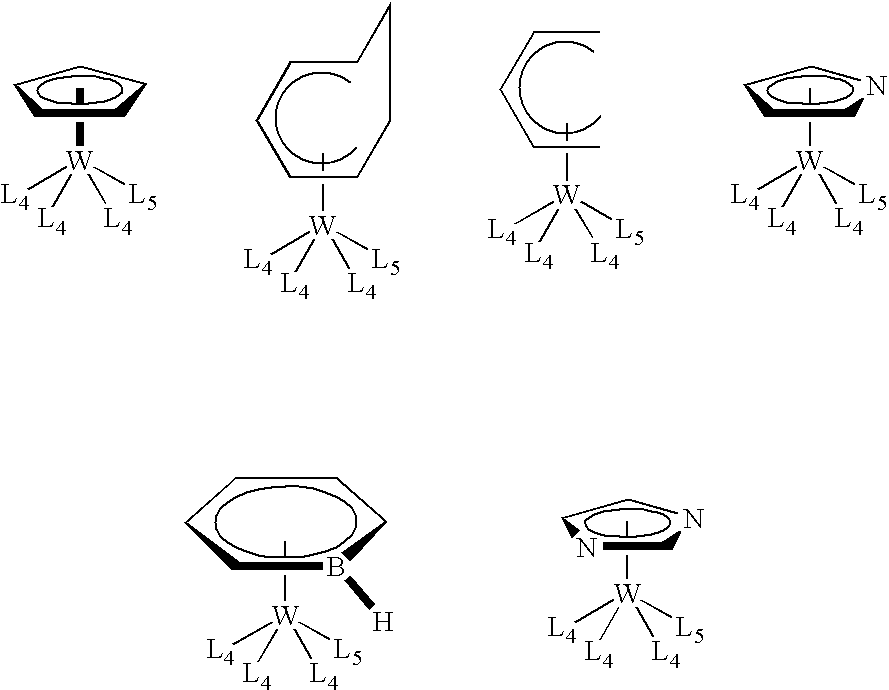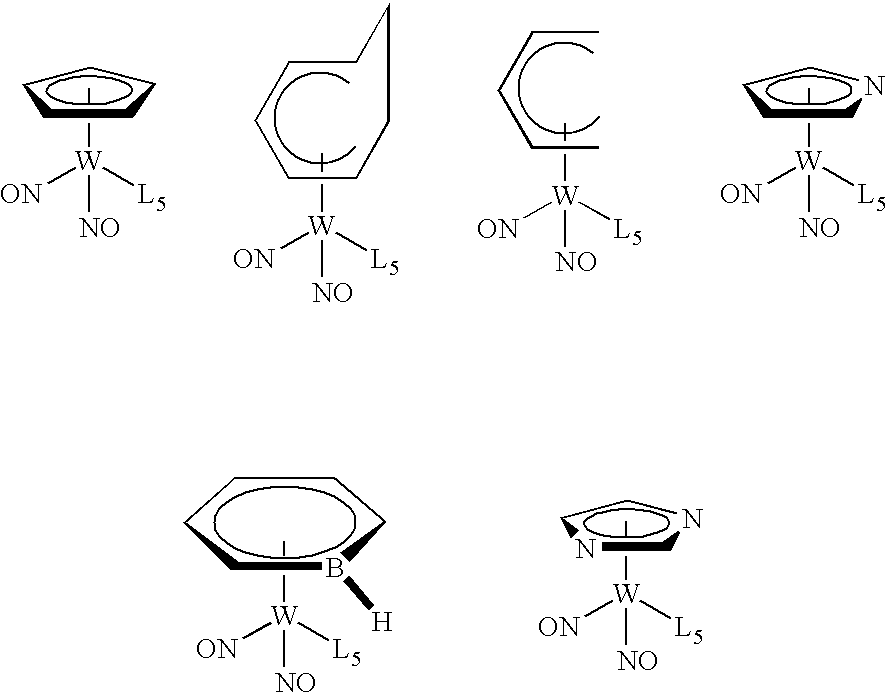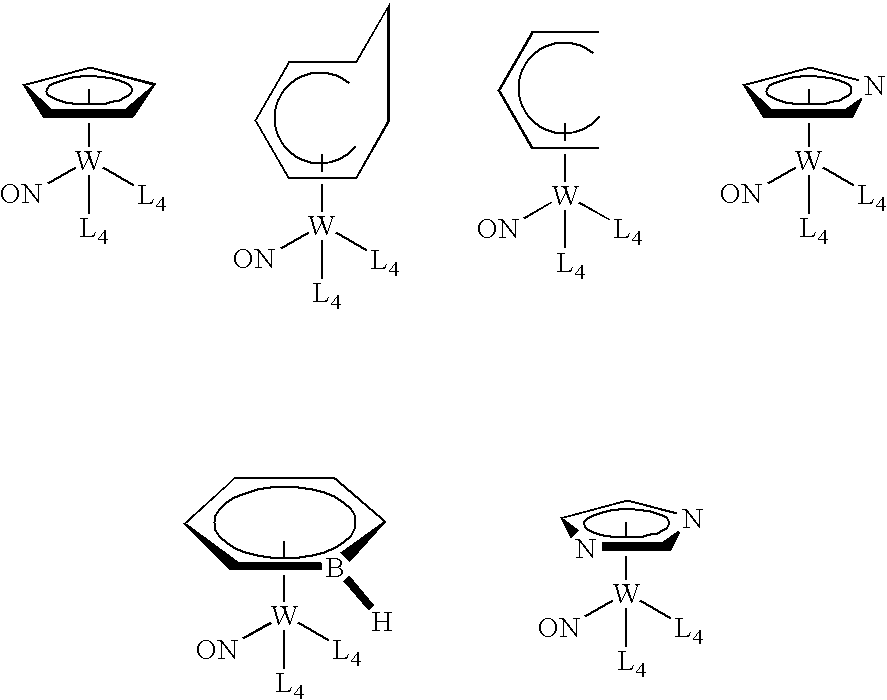Organometallic compounds, processes for the preparation thereof and methods of use thereof
a technology of organic compounds and processes, applied in the field of organic compounds, can solve the problems of compromising the integrity of the device being formed, unacceptable levels, and traditional pvd techniques that are not well suited to providing conformal coverage on the wall and bottom surfaces of high aspect ratio vias and other features, and achieves better reactivity with semiconductor substrates.
- Summary
- Abstract
- Description
- Claims
- Application Information
AI Technical Summary
Benefits of technology
Problems solved by technology
Method used
Image
Examples
example 1
Synthesis of Lithium Ethylcyclopentadienide
[0179] An oven dried 2.0 liter round-bottomed 3 necked flask was equipped with a Teflon coated stir bar, and a 500 milliliter dropping funnel, and a stopcock adapter. The remaining neck on the flask was sealed with a rubber septum. The flask was then connected to a nitrogen / vacuum manifold via Tygon® tubing, and the contents of the flask were evacuated and backfilled with nitrogen three times.
[0180] Anhydrous hexanes (500 milliliter) was then cannulated into the flask and the 2.0 liter flask was cooled inside of a cooling bath to −10° C. To this solution, freshly cracked ethylcyclopentadiene (97.5 grams, 1.06 mol) was added. N-butyllithium (380 milliliters, 2.5 M in hexanes, 1.0 mol) was then added to the dropping funnel. The n-butyllithium solution was then added dropwise to the ethycyclopentadiene solution while stirring. The temperature of the reaction was monitored by thermocouple and during the 3 hour addition the temperature was mai...
example 2
Synthesis of Li[(EtCp)W(CO)3)]
[0182] An oven dried 3.0 liter flask was fitted with a condenser, a mechanical stirring shaft and a rubber septum. A stopcock adapter was fitted to the condenser the assembly was then connected via the stopcock adapter to a nitrogen / vacuum manifold with Tygon® tubing. The contents of the flask were evacuated and backfilled with nitrogen three times.
[0183] While under vacuum, the apparatus was disconnected from the nitrogen / vacuum manifold and transferred inside of an inert atmosphere glovebox. The rubber septum was removed and tungsten hexacarbonyl (300 grams, 0.85 mol) was loaded into the 3.0 liter flask. The rubber septum was replaced, the flask was taken out of the glovebox and reconnected to the vacuum / nitrogen manifold.
[0184] Dimethoxyethane (1.0 liter, anhydrous) was then cannulated from a Sureseal® bottle into the reaction vessel, and the solution was stirred. The tungsten hexacarbonyl exhibited negligible solubility in this solution, and appea...
example 3
Synthesis of (EtCp)W(CO)3H
[0188] To a 3 necked 1.0 liter flask, a stirring bar and 2 rubber septa and a stopcock adapter were connected. The flask was then connected to a nitrogen / vacuum manifold and evacuated and refilled three times. Dimethoxyethane (500 milliliters) was then cannulated into the vessel and the liquid was stirred. Glacial acetic acid (51 grams, 0.85 mol) was then added to the vessel by syringe through a rubber septa. The solution was then sparged with N2 for 30 minutes.
[0189] A solution of Li[(EtCp)W(CO)3] in dimethoxyethane (0.85 mol Li[(EtCp)W(CO)3] in 1.5 liters of DME)] was prepared as described in Example 2. A rubber septum was removed and replaced with an oven dried inert atmosphere 1.0 liter dropping funnel.
[0190] The glacial acetic acid solution in DME was then transferred from the 1.0 liter flask to the 1.0 liter dropping funnel by canula under an inert N2 pad. The contents of the dropping funnel were added dropwise over 2 hours. During this time brown ...
PUM
| Property | Measurement | Unit |
|---|---|---|
| temperature | aaaaa | aaaaa |
| temperature | aaaaa | aaaaa |
| pressure | aaaaa | aaaaa |
Abstract
Description
Claims
Application Information
 Login to View More
Login to View More - R&D
- Intellectual Property
- Life Sciences
- Materials
- Tech Scout
- Unparalleled Data Quality
- Higher Quality Content
- 60% Fewer Hallucinations
Browse by: Latest US Patents, China's latest patents, Technical Efficacy Thesaurus, Application Domain, Technology Topic, Popular Technical Reports.
© 2025 PatSnap. All rights reserved.Legal|Privacy policy|Modern Slavery Act Transparency Statement|Sitemap|About US| Contact US: help@patsnap.com



